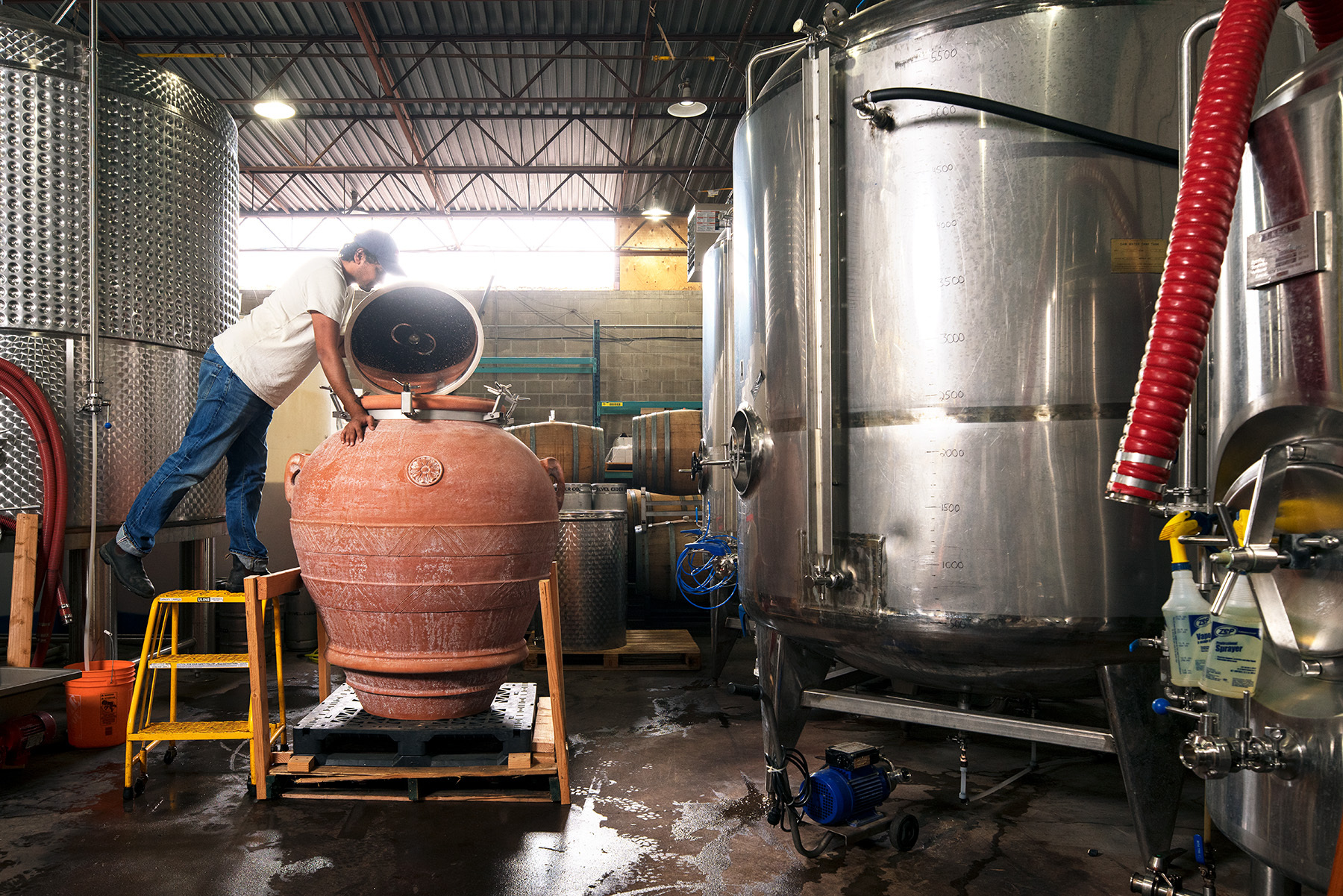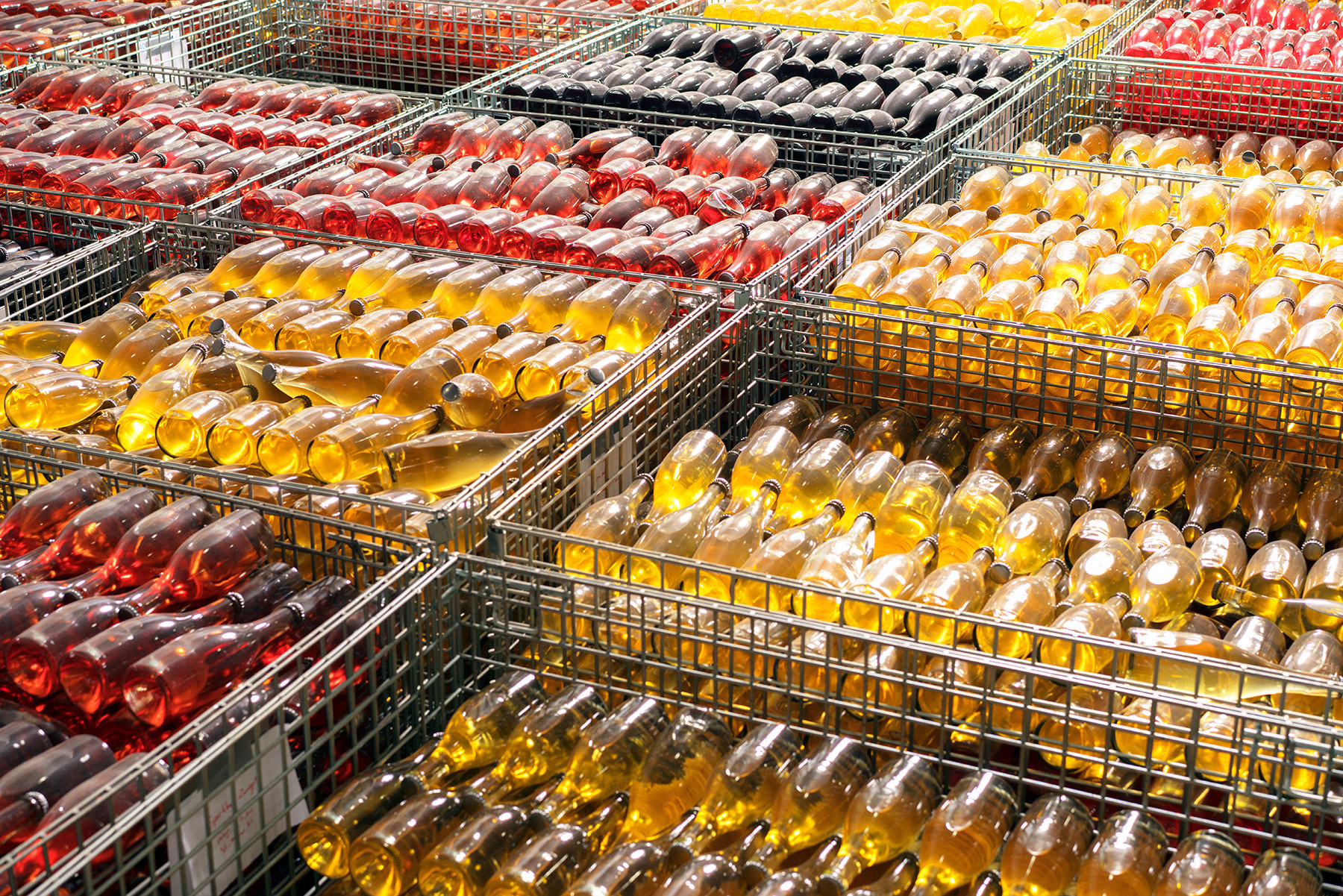It’s odd for a cider maker to hunt for ingredients in any season but autumn, when apples pull down branches as if begging to be picked. But, on a hot afternoon in late May, twenty-nine-year-old Tariq Ahmed is driving a white delivery van through Guelph, a leafy university city in southwestern Ontario, scanning the roadsides. “Here we go,” he says, pointing to a thicket separating the highway from a residential street. “Gold mine.”
Ahmed pulls over and begins snipping off his bounty: purple conical lilac blossoms. The lilacs are growing on city property, so he’s technically not trespassing. “There’s a lot of stuff that’s weirder than this that’s happening in Guelph,” he says, like people taking their pigs for a walk down the street. But weird is what Ahmed is going for. The lilacs that he picks during this short spring flush will be added to a batch of apple and golden plum cider for a line called Ostara, where each drink is flavoured with a different flower. It’s just one of the many revolving products he creates for Revel Cider, which he founded in 2014.
Earlier that day, Ahmed had been foraging for pink crabapple blossoms near some railroad tracks; the next day, he had plans to pick dandelions at an organic farm outside the city. These are not common ingredients in cider making, a craft that most often ferments apple juice to produce a light and refreshing alcoholic beverage. To most people, cider is a simple, sweet, and unfussy summer drink. Some of the more adventurous creators toss in the odd stone fruit, like cherries or peaches, for variety. Revel, though, is different. Yes, Ahmed’s cidery produces several 100 percent apple ciders, but it’s also come to represent a reinvention of the drink itself: surprising flavours, blends, additives, and mostly forgotten techniques that go well beyond what consumers usually find in a bottle.
Behind a commercial strip toward the outskirts of Guelph, Revel’s cidery feels part traditional brewery, part science lab. There are storey-tall vats of cider blended with wine; cider with whole cherries bobbing on the surface; cider with yellow plums that’s awaiting those dandelions. In one corner, there are two five-foot-tall amphoras—clay jars used by ancient Greeks and Romans to store wine—that Ahmed imported from northern Italy to see how the natural minerals might mellow the acidity of the cider fermenting inside.
Revel began eight years ago, at a time when brewers and drinkers were just starting to see cider as an untapped market. (The following year, Bon Appétit proclaimed, “Hard cider is having its craft beer moment.”) After decades of cider being a sidelined drink—cans of Strongbow and Growers clustered alone on a menu or tucked away in a liquor store—major brands were beginning to see the potential in diversifying beyond lagers and ales and started turning to apples. Alexander Keith’s—owned by Labatt, part of the global Anheuser-Busch conglomerate—began offering a cider in 2012, followed the next year by Molson Canadian Cider. Both products were simple drinks whose dominant flavour was sweet apple—an easy, approachable entry point that tasted like Minute Maid left out in the sun. But, alongside these bog-standard products, a shift was taking place: small-scale cideries like Revel began popping up all over North America and were rethinking what cider could be.
According to StatCan, sales of cider (along with “coolers and other refreshment beverages”) have more than tripled in volume from 2011 to 2021. It reports that wine consumption is down and that Canadians are drinking less beer than at any point since it started tracking alcohol sales and consumption in 1949. However, the cider category saw a staggering 40.2 percent surge in the 2020/21 fiscal year—the largest annual increase StatCan has recorded.
Revel is still a small producer, and its sales make up only a tiny fraction of this market growth, but it’s nonetheless at the vanguard of the new cider wave. As its reach has increased—distributing to consumers, restaurants, and bars across Canada as well as abroad to countries including Mexico, Australia, France, Sweden, and Japan—so, too, has its renown. In 2020, consumers ranked Revel the third best cidery in the world on ratebeer.com, the largest online alcohol forum.
In a marketplace of Goliaths dominating alcoholic production worldwide—the Molson Coors, the Heinekens, even the Growers—it takes a particular kind of David to survive. Revel has realized that, to take on the giants who flood the market with similar-tasting, predictable products, a small producer like it needs to not only expand who a typical cider drinker might be but also change our relationship with alcohol itself.
As is the case with many inventors and artists, Ahmed began Revel Cider out of a mistake. During the summer of 2013, he was interning on a farm as part of his studies in plant science at the University of Guelph. He grew vegetables and raised animals. He tried his hand at cheese making and pickle brining but, eventually, found himself drawn to the unpredictable chemistry of alcoholic fermentation. One of his first attempts was a blend of apple juice and honey, a kind of cider-meets-mead called cyser. He pressed the juice, added honey, and let it sit, stacking the bottles on a shelf in the tent where he slept. One night: pop! “A cork shoots out of one of them, and I woke up soaked in this honey stuff,” Ahmed says.
It was a rookie mistake: he had bottled the cyser too early, before the fermentation process—yeast eating the sugar in the juice to produce alcohol and carbon dioxide—had fully stopped. The excess gas built up and bam. Explosion. It’s the kind of disaster that might be disheartening, even dissuading, to some neophytes. But, ever the budding scientist, Ahmed saw it not as a failure but as a point of data. “It’s more about learning what works and what doesn’t,” he says.
Ahmed, undeterred, started pressing anything he could get his hands on: apples, grapes, mulberries. Guelph, he realized, with its orchards dating back to the mid-1800s, was an ideal base for cider making. He would visit local farmers’ markets every week and buy a couple bushels of whichever apple varietals were available to test what each one brought to a cider. “Every grower and growing region is different, so the varieties are going to taste different,” Ahmed says.
“I really wanted to do it myself and learn from scratch by trial and error.”
He rented space at a large cidery and began to use its equipment—industrial presses and fermentation vats—to produce what he felt customers might want at that time: a classic apple cider. Made from 25 percent golden russet and 75 percent northern spy apples, Revel’s first flagship product was filtered and what’s called “back sweetened,” where sugar is added toward the end of the process to create a sweeter, more approachable drink. In its first year, Revel produced 20,000 litres of cider, selling kegs wholesale to restaurants and bars in Guelph and Toronto, riding the craft-beer tsunami that was cresting across North America. It was still a one-man operation, and business was good.
Companies often develop one product, find a customer base, and then cautiously branch out. While Revel’s main apple cider was what took the company off the ground, the product was, in Ahmed’s opinion, a bit boring. It was just too similar to most cider you could find on tap at the time. “That just wasn’t what we were interested in,” he says. In 2016, a year and a half after launching, Ahmed pulled the cider off the market. “We were pretty confident that we could make a new flagship product that’s in the style of something we wanted to drink,” he says. At the time, that one traditional cider represented 40 percent of the company’s sales. The remainder was what he was particularly interested in, early versions of what the company produces now: unfiltered, unadulterated, no-sugar-added ciders, some blended with various fruits or botanicals—flowers and leaves. “Those were the products we wanted to take home and drink ourselves,” he says.
This vision for cider had more in common with the world of natural wine, a movement in viticulture toward organic and minimal-intervention processes that often result in funky, nuanced flavours. Cider, Ahmed realized, could be just as exciting and complex as wine, just as boundary pushing as craft beer. The guiding principle became: follow the feeling he had when those bottles of cyser exploded.
But there was just one problem. Cider making began in Europe, and producers there have the luxury of drawing upon hundreds of apple varietals that are perfect for the job—apples like the chisel jersey, the dabinett, the porter’s perfection. They not only offer complex flavour and body but are also high in tannins—organic compounds that produce that dry mouthfeel you get with red wines. But North Americans simply don’t have the same access to these fruits, and cider makers hoping to stand out here have little in the way of guidance. Though we have a long and storied relationship with cider, in the twentieth century, the practice and art of North American cider making was almost entirely wiped out.

People have been fermenting apple juice into alcohol in Europe for at least two millennia. It is a history replete with stories of a drink with hidden magic: French monks tending to orchards of cider apples after their daily matins; English farmers making a rough and potent homebrew called scrumpy (to scrump is to steal fruit); Basque sailors stocking barrels of cider in their holds to ward off scurvy. And all of this carried over to the Americas.
Prior to European colonization, alcohol in North America was primarily based on corn, cactus, and, in some cases, berries. Starting in the 1600s, the seeds of apples—as well as those of peaches and pears—were brought and planted by various colonists (including, later, by John Chapman, better known as Johnny Appleseed). In Canada, most of these early plantings—in the Maritimes, in Quebec and Ontario, and eventually in British Columbia—weren’t meant to produce apples for eating but for drinking. Those varietals were nothing like the sweet apples found in grocery stores today. They were bitter and tart and acidic—perfect for fermenting into drinks whose alcohol content ranged from 3 to 12 percent. Cider, above beer and spirits, became the primary booze of the Americas, made by centuries-old techniques brought over from England, France, and Spain.
The apples grown in North America, however, were distinct, even from those of the same varietal long grown in Europe, for a reason inherent in the fruit itself. Apples are an “extreme heterozygote,” which means that, while they can reproduce easily from seed, they don’t pass on a perfect genetic replication. A seedling’s eventual fruit, therefore, can be markedly different in taste and appearance than its parent. Instead of letting the fruit grow from seeds, orchardists would graft a shoot from a desired apple varietal onto the trunk of another tree in order to maintain genetic—as well as characteristic—consistency. (North American orchardists preferred grafting Old World apple varietals onto the stocks of crabapple trees, as it was the only apple native to the continent.) The apples grown in Canada and the US, and the cider produced from them, were in every way unique.
By the mid-twentieth century, however, cider here had all but evaporated. The cause of its rapid decline is still hotly debated. Some blame the temperance movement of the early 1900s, alleging that antidrink fanatics—like Carry Nation, a radical prohibitionist in the American south who famously carried a hatchet to splinter wooden bars at saloons—sparked a movement to fell or burn apple orchards across the US. Another often-debated hypothesis is that Quebec’s booming industry was shuttered when the province’s postprohibition Loi des liqueurs alcooliques erroneously omitted cider from its regulations, limiting sales for decades.
Other theories point to droughts or blights or to German immigrants who brought more refined beer-making techniques that eventually pushed out cider. A simpler explanation is most likely to be true: in the aftermath of two world wars and the dry blanket of prohibition, beer and spirits were just easier to manufacture. When a flood, a fire, or a windstorm tears down an apple orchard, it takes decades for newly planted trees to bear enough fruit to restart a commercial venture. Grain, on the other hand, could not only be easily replanted and harvested the following season but was also easier to transport and store, particularly as urbanization increased and rural manufacturers moved downtown.
As Canadian provinces emerged from prohibition, cideries did pop up slowly. But cider’s time as North America’s leading drink appeared to be over. One maker rose from the ashes and came to define the market, both in sales and in Canada’s national consciousness, for the next half century. Founded in the fertile grounds of southern Vancouver Island in 1922 as a fruit-packing plant, Growers began producing cider in 1962. It’s also come to exemplify the defining characteristics of North American cider through the second half of the twentieth century: sweet and forgettable.
How do you convince a country that cider doesn’t have to be boring? In Chénéville, Quebec, a microcidery called Les Pommes Perdues is producing ciders from apples collected off wild or abandoned trees. On Pender Island, sandwiched between Vancouver Island and mainland BC, the young cider makers of Twin Island Cider build their own amphoras, in which they ferment some of their products, from locally harvested clay. Travel to any province where apples are grown, and you can now find a small-scale cidery juicing and fermenting, squeezing magic out of the countryside.
While many other small operations are limited by how much they can produce, Revel has stood apart, thanks to the diversity that emerges from its cidery. “A lot of companies will put out two or three products and maybe experiment with one or two new ones a year,” Ahmed says. “I think that’s not the way a lot of our generation drinks now.” In 2021, Revel sold around eighty different products—many were created in limited quantities and made available on its website for just a few weeks at a time. Ahmed was aiming for two distinct releases every week and nearly hit that goal.
Alongside several different apple ciders, Revel produces Perry, a pear cider made in part with juice aged in oak barrels; Sonata, a cherry cider; and Mithras, made with nectarines and elevated with the earthy spice of sassafras. Then things get weird. There’s Bittersweet Freedom, made of hyslop crabapples (Ahmed knows of just three trees in Ontario that grow this apple, and they produce fruit only every other year). There’s Ribbon, a blend of red plums and blueberries and rosé grape juice. Fountain mixes apple juice with blueberries that have been sweetened with hyssop, a shrub in the mint family. And Mirabelle takes a base of apple, then throws in strawberries and lemon verbena. Most of Revel’s ciders take three years to be bottled or canned: apple-juice fermentation in the first year; another fruit added whole in the second; and a botanical incorporated in the third.
Revel’s turn toward strange leaves and flowers has partly to do with the desire to stand apart—but also with necessity. Botanicals are added not just for a subtle echo of flavour but to introduce those key tannins—the compounds that bring so much more complexity to wine. “You have to find different sources of tannin if you want to make a beverage that has texture without sugar,” Ahmed says. Many plants produce tannic flowers, with a bitterness designed to ward off insects and animals. It is in these botanicals that Ahmed has found a solution to North America’s dearth of cider-friendly apples: marigolds, crabapple blossoms, dandelions, and lilacs can really make a cider stand apart. Others can also impart some sweetness, allowing Revel, as a company rule, to produce no-sugar-added ciders that would all be considered “dry.”
To turn juice into cider means fermentation, and here, too, Revel is doing something different. Most alcohol is fermented with a highly stable and reliable commercial yeast. But yeasts can be found everywhere outdoors, even floating in the wind. These wild yeasts are what turn an inert sludge of flour and water into a sourdough bread starter or the sweet juice of apples into a frothing, fizzing liquid—something alive and full of potential. Wild yeasts are often scrubbed from fruit before it’s processed, but Ahmed allows them to be Revel’s agent of fermentation, making each batch of cider slightly different. If you buy a bottle of Bittersweet Freedom this year, it will taste slightly different than one bought in 2020—and that’s the point.
Throughout the early twentieth century, the expansion of industrial production and bottling, both of soft drinks and alcohol, created the broader cultural expectation that products should always taste the same. Just as we expect every sip of Coca-Cola to be alike—from bottle to bottle, year after year—we expect that every can of Budweiser or Guinness or Strongbow will always, and should always, taste like the one before it. Recipes are followed to the millilitre, and variations from raw materials are levelled out through blending.
Revel, along with a new generation of winemakers and brewers, is slowly upending this norm. Its ciders fluctuate in taste not only with the changing availability of a particular fruit but also with the turning of the seasons: how acidic a batch of nectarines was or how sweet the pears were that year can all be sensed from the bottle. A particularly cold winter will slow fermentation, and you can taste that difference. It’s a process undoubtedly more inconsistent, but what is produced ends up being a reflection of the climate and ecology of a specific region at a specific moment in time.

When it comes to many of these unusual ingredients or techniques, there’s no recipe, no guide. It’s Ahmed or one of his employees tasting and testing and seeing potential in what the harvest brings. Or it’s Ahmed scouring history books and online records for old techniques of wine, beer, or cider making that have fallen out of favour. This was the case in 2020, when Revel first released ciderkin, a kind of low-alcohol cider (around 2 percent) that was historically given to children and is made by rehydrating and refermenting “pomace,” the apple paste left over after extracting juice. However, not all of Revel’s products work out: its beet and carrot ciders, for example, never proved popular with buyers. (Ahmed realized then that there is a line, even in experimenting.)
In this way, Ahmed is helping grow a new language for drinkers, cobbling together terms or poaching words from other processes, other beverages, and other eras. He believes Revel is the first Canadian cidery to produce pét-nat cider, a beverage made with a winemaking technique in which carbonation develops naturally in the bottle to produce a soft bubble. Revel now also has a version of vermouth made with crabapples, cherries, and Gewürztraminer grapes, rounded out with apple blossoms, blue spruce tips, and white pine shoots.
At the beginning, “we just didn’t have a name for what we were doing,” Ahmed says. To be labelled and sold as “cider” in Canada, according to federal Food and Drug Regulations, it must contain at least some apple juice. But what can be added is limitless. For Revel, what ends up bottled is sometimes hard to define: Do you call a drink that’s half apple juice and half grape juice a cider or a wine?
It leads to the question: Why all the strange flavours and obscure techniques instead of just giving people what they already know and want? Why make products that are available for a few weeks and are then gone from shelves until next year? To that, Ahmed gives a simple answer: “Because it’s interesting to us.” He thinks back to when, as a teenager, he would walk to high school and pick fruit that drooped over fences and pluck flowers and other edibles to see what they tasted like. Revel, it seems, is trying to bottle that experience of earnest discovery. “Truly, that’s one of the most exciting things in the world to me,” Ahmed says—that you can introduce tropical flavour, for example, using only flowers native to Ontario. “It’s what we want to share with other people and also what we want to discover more of for ourselves.”
Revel, since its founding, has never had a traditional salesperson. In the world of alcohol, where old-school door-to-door sales still rule, this is unheard of. Revel has never even been on the shelves of Ontario’s LCBOs. To find customers, Ahmed has relied almost entirely on social media. In 2015, he launched Revel’s Instagram account with an eye to sharing educational, behind-the-scenes peeks into how cider is made. He recently pivoted to TikTok. What’s worked has been a bit of science and a dash of nerditry, all packaged earnestly and honestly in a how-it’s-made presentation. “It’s very much me explaining something weird, as far as a concept or what led us to make a certain product, and then soft selling a product at the end of that video,” he says. Though the company can’t yet sell directly to US customers, half of Revel’s TikTok engagement and newsletter subscribers are there—ready whenever the red tape is cut.
The company grew steadily, year over year, until 2020, when COVID-19 hit and lockdowns upended how people drank. Larger companies don’t sell directly to the consumer, so, Ahmed says, for the first year of the pandemic, “we were given this pseudomonopoly on alcohol sales, with all the bars and restaurants being closed down.” Before the lockdown, direct-to-consumer sales were 10 percent of his business; they jumped to almost 100 percent in 2020, with overall sales doubling. “We were scrambling a little bit,” he says. He quickly doubled his staff to eight, increasing operating costs significantly. While Revel produced 140,000 litres of ciders, wines, and vermouth in 2021, Ahmed is wary of growing too big too fast, as that would mean abandoning the company’s ethos. His dandelion cider, for example, would be impossible to produce in massive quantities. “We would need a hundred people out picking dandelions,” he says.
Wine can be very serious, and beer is the epitome of casual. But there’s something inherently quirky about cider and its various oddball expressions—a kind of alluring back-orchard scrappiness. In this spirit, Revel’s new offerings may emerge out of Ahmed’s stumbling upon a pamphlet on Norman cider making or after he chances across a patch of roadside flowers, nibbling to test their sweetness, adding a dash of this or a handful of that and seeing what might explode.




